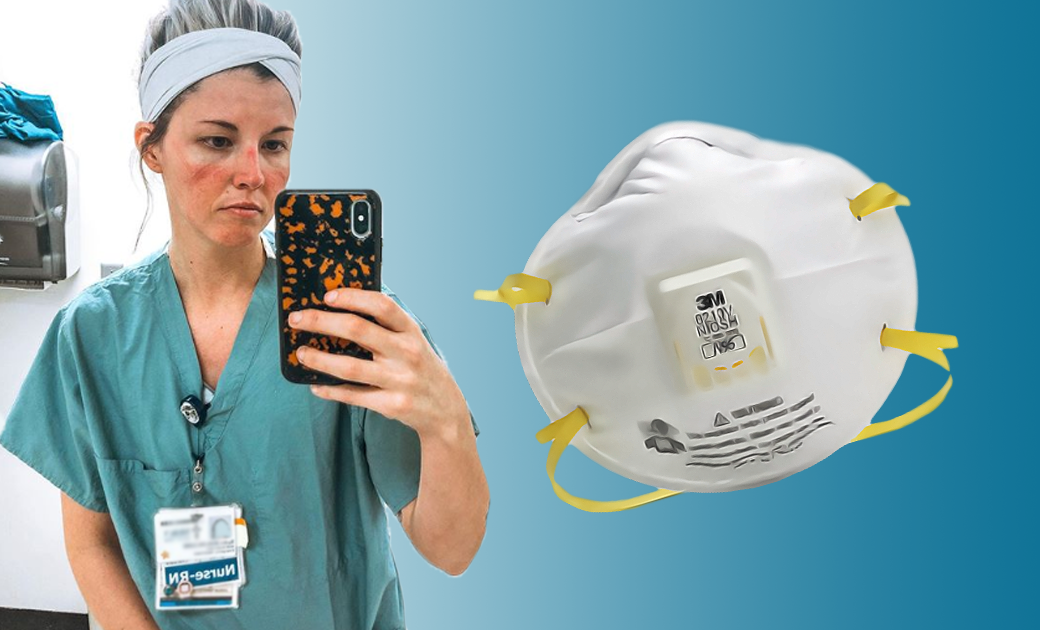Understanding the Risk of Using Reprocessed N95 Masks During Covid-19 Pandemic
Shortages of N95 masks are forcing desperate measures. Decontamination of masks for multiple uses is a viable, low-risk-option under these extreme circumstances.
As the Covid-19 outbreak rages on in the United States and across the world, healthcare facilities are facing an acute shortage of personal protective equipment (PPE), including the N95 masks (technically, they are referred to as FFRs or filtering facepiece respirators). There is news of frontline healthcare staff and first responders stretching the use of these otherwise single-use, disposable masks for long hours, and in some cases, having to reuse the same mask multiple times.
This is clearly a high-risk activity. Healthcare workers and first responders are at the frontline of our fight against the SARS-CoV-2 novel coronavirus which causes the Covid-19 disease. If they are infected and unable to take care of the critically ill patients, it will have a disastrous effect on the overall capacity of the healthcare system in managing the large number of Covid-19 patients.
Recently, the FDA has authorized the emergency use of the Battelle CCDS Critical Care Decontamination System, which uses vapor phase hydrogen peroxide to decontaminate N95 or N95-equivalent respirators for reuse by healthcare personnel. In this blog, we review this practice of reusing disposable FFRs after decontamination within the context of a benefit-risk assessment relevant to the current Covid-19 public health emergency.
To be clear, these FFRs are disposable Class II medical devices (FDA Device Code MSH), not cleared for reuse. During an emergency, such as a pandemic, CDC recommends an extended use or reuse under a local infection control procedure. According to the CDC guidance, extended use refers to the practice of wearing the same N95 respirator for repeated close contact encounters with multiple patients, without removing the respirator between patient encounters. Reuse refers to the practice of using the same N95 respirator for multiple encounters with patients but removing it (“doffing”) after each encounter.
The SARS-CoV2 coronavirus is considered to be highly contagious. Since healthcare workers are in close contact with Covid-19 patients, these practices of extending or reusing the same N95 respirator create a high level of risk for them.
The most desirable solution is to increase the production of fresh N95 respirators and ensure there is adequate supply for healthcare facilities across the country, especially within the hot spots with rapidly accelerating new cases. To this effect, several leading manufacturers such as 3M and Honeywell have announced plans to rapidly increase their production capacity.
However, it will still take some time before the supply catches up with rising demand. In the meantime, reusing a N95 respirator after appropriate decontamination can be a viable, low-risk option.
Here, it is important to note that decontamination is only one of the ways to reprocess medical devices in the industry. Decontamination does not mean sterilization, which has a very clear definition as shown in the graphic below. Similarly, there is difference between disinfection and decontamination. It is important to fully understand the claim being made in the labeling of the reprocessing device so an informed decision can be made within the context of a benefit-risk analysis.
Let us break it down to understand the risk of using reprocessed N95 respirators.
ISO 14971, the International Standard for Risk Management of Medical Devices, defines the term risk as a combination of the probability of harm and the severity of that harm. Harm, within the context of ISO 14971 is injury or damage to health of people, or damage to property or the environment.
In this situation, the effect of getting infected with the Covid-19 disease may result in various harms - minor symptoms similar to a seasonal flu on one end of the severity scale, or acute respiratory syndrome requiring critical medical care on the other end. In extreme cases, it can also result in death.
These harms have different severity levels depending on the outcome. However, since the case fatality rate (CFR) for Covid-19, caused by this novel coronavirus SARS-CoV-2 is currently estimated to be more than 1%, we should consider the highest severity harm of death for this analysis.
The only variable we have some control over is the probability of harm. We can limit the exposure to the SARS-CoV-2 coronavirus to limit its spread, thereby reducing the probability of infection and subsequent harm. That is why there is a stay-at-home order in place in most parts of the country.
However, this is not possible for the healthcare workers who are exposed to Covid-19 patients as part of their daily work. The N95 respirator is designed to protect both the patient and the healthcare personnel from transfer of microorganism, body fluids and particulate material. Reprocessing of the N95 respirator can potentially compromise both form and function of this medical device.
Clearly, if a compromised N95 respirator is used, the probability of harm increases, causing the risk of harm to increase. The benefit-risk balance is no longer acceptable.
On the other hand, if the decontamination process is shown to yield a reasonable level of confidence in reduction of pathogens without compromising the form and other functional attributes, then the probability of harm does not increase by a significant amount. It is higher than a pristine N95 respirator fresh out of the original packaging, but not as high as the one used for an extended period of time, or reused without any processing, such as decontamination or sterilization.
Similarly, if the reprocessing step involved sterilization, as defined in the graphic above, without any impact on other functional attributes, the probability of harm will be about the same as that of a pristine N95 respirator.
The Battelle decontamination system uses vapor phase hydrogen peroxide, which is proven to be effective in eliminating pathogens and spores, more resistant than SARS-Cov-2. According to a 2016 report by Battelle, 6 log reduction of Geobacillus stearothermophilus spores was achieved in a cycle that included a 10 min conditioning phase, 20 min gassing phase at 2 g/min, 150 min dwell phase at 0.5 g/min and a 300 min aeration phase such that no “off gassing” of hydrogen peroxide was detected. It was also shown that no degradation was observed up to 50 decontamination cycles, although there was damage to the strap after 30 cycles.
Limitations to the study included only one model of N95 tested and only a small-scale unit was used. Further, the study did not include any viruses.
Given these limitations, the claim by Battelle is decontamination against the SARS-CoV-2 virus contamination and the FDA Emergency Use Authorization is limited to a maximum of 20 cycles per respirator. There are also very detailed requirements for the chain of custody of these respirators starting from the point of collection at the healthcare facility, through the reprocessing, and return to the same healthcare facility. FDA is also requiring specific labeling and fact sheets and instructions for healthcare providers and personnel.
A key point to appreciate is that in the current environment, there is no adequate, approved and available alternatives to the emergency use of this decontamination system. This is one of the criteria used by the FDA for granting the Emergency Use Authorization.
Benefit remains the same – protection against transmission of microorganisms, barrier to fluids and particulate matter. Risk is slightly higher compared to a pristine N95 respirator, especially if there are use-errors during the chain of custody process, or malfunction of the decontamination system. However, the risk is not as high as the alternative of extended use or reuse of the same N95 respirator.
Benefit-risk is not an exact science. There is no formula that can be used for a quantitative analysis. In most cases, a judgment is made using all available data, prior experience, nature of the circumstances and the type of risk. In this context, the overall benefit-risk of using reprocessed N95 respirators using this decontamination process is still favorable.
In conclusion, reusing a N95 respirator to protect against exposure to Covid-19 is a high-risk activity. Reprocessing these respirators before the reuse, through decontamination, disinfection or sterilization significantly mitigates the overall risk. In this context, the use of Battelle’s decontamination system as authorized by the FDA using the Emergency Use Authorization is a viable, low-risk option to extended use and reuse of these respirators. Application to other types of respirators is possible but potentially at a relatively higher level of risk.
Acknowledgements
We thank Jim Agalloco of Agalloco & Associates for valuable suggestions and technical information during the preparation of this article.
References
Battelle CCDS Critical Care Decontamination System – FDA Emergency Use Authorization, March 2020
CDC – Recommended Guidance for Extended Use and Limited Use of N95 FFR in Healthcare Settings, March 2020
ISO 14971 – Application of Risk Management to Medical Devices, December 2019
2016 Battelle Report – Bioquell HPV Decontamination for Reuse of N95 Respirators, July 2016
FDA Emergency Use Authorization for the Battelle Decontamination System, March 2020


